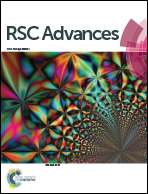Biological phosphorylated molecules participate in the biomimetic and biological synthesis of cadmium sulphide quantum dots by promoting H2S release from cellular thiols†
Abstract
Developing methods with a low environmental impact for nanoparticle synthesis remains one of the greatest challenges in nanotechnology. In this context, biomimetic and biological methods have emerged as green chemistry alternatives, and also contribute to our understanding of how nanomaterials interact with cellular molecules. Here, we report a phosphate-dependent biomimetic method to synthesize of cadmium sulphide (CdS) QDs at low temperatures, physiological pH and aerobic conditions, using CdCl2 and thiols (L-cysteine, glutathione or mercaptosuccinic acid). Inorganic phosphate (Pi) and cellular phosphorylated intermediates such as adenosine monophosphate, glucose-6-phosphate, glycerol-2-phosphate and fructose-1,6-biphosphate, can trigger CdS QDs synthesis. The produced QDs are cubic phase nanocrystals with a tunable fluorescence (450–700 nm), small size (4–12 nm), and are composed of thiols and Pi. In CdS synthesis, the importance of the phosphate is related to its capacity to release H2S from thiols, a phenomenon associated with its base-properties. Based on the biomimetic method, we developed a Pi-based procedure to synthesize CdS QDs in Escherichia coli. As in the biomimetic procedure, Pi favors QDs-biosynthesis not only by mediating biological generation of H2S, but also by improving Cd2+ cellular uptake. A role for phosphates in the cellular interaction and green synthesis of metal QDs is discussed.



 Please wait while we load your content...
Please wait while we load your content...